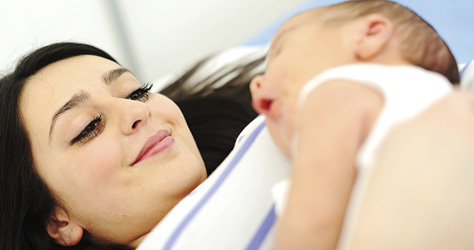Your 4 month old baby development milestones
At four months old your baby's development will be speeding up. Along with improved senses, they will likely be going through the early stages of speech development and may even have the early signs of their first teeth.
At a glance
- Rolling over may be about to happen
- Entering teething territory
- Encouraging them to explore materials

Your baby’s senses at four months old
Further development of their touch
Your baby will be fascinated by anything with a texture now – crinkly, shiny, lumpy or furry. Most of the objects they touch, whatever their texture, will go straight in their mouth. Sometimes they will hit themselves in the face with the toy and cry, giving you a look as if to ask, ‘Why did you do that, Mum?’
What your baby can see
Their vision has really come on since those first few fuzzy images at birth – your baby can now see across the room, although they will still prefer to look at things close-up. If you can see any squint, contact your health visitor as it’s important to get checked out.
Although they can see colour from birth, your baby will now be much better at distinguishing between different shades, being able to more accurately work out the difference between similar shades. This can be a great time to introduce more colourful toys and books which they’ll love looking at.
Your baby’s motor skills at four months old
Speech development
If you listen carefully to your baby’s babble you may be able to make out vowel and consonant sounds: p and b sounds when they’re unhappy and guttural sounds like j and k when they’re happy. They may also be able to imitate the sounds you make now, so if you say boo, they may try to say it back.
Rolling on
Rolling over is more likely now. The age at which babies first roll over varies – some are ready at three months, some not until six or seven months. So it may happen this month. Or it may not. You can’t force it but you can gently encourage it by putting a favourite toy by their side and see if they roll over to get it.
You may also notice that whilst laying on their front, they’re able to arch their back. This is a good exercise that can help them develop their neck muscles further and is a good way for them to start developing the muscles they’ll need to sit up and eventually crawl, stand and walk.
Other 4 month old baby developments
First teeth
Your baby can get their first teeth any time from three months to one year old, but they may start gnawing their fist and frantically rubbing their gums about now in preparation for the trials and tribulations to come. If they get red patches on their gums and are dribbling a lot you’ll know the first tooth (usually a bottom front one) is probably on its way.
Feeding less
In the first few months you’ll have been feeding more regularly than they are by month four. This is because your baby’s stomach is now bigger than before, meaning they can take on more milk during each sitting.
Weaning
Weaning is an exciting and fun development stage which should start when your baby is around 6 months old. At 4 months it’s a good time to start preparing for this development milestone and learning about the signs that show your baby is ready. Think about which foods you will introduce to your baby first and find out about the benefits of combining spoon feeding and baby-led weaning.
Next round of immunisations
6-in-1 vaccine – 3rd dose - at 16 weeks protects against diphtheria, hepatitis B, Hib (Haemophilus influenzae type b), polio, tetanus, whooping cough (pertussis)
MenB vaccine – 2nd dose - at 16 weeks protects your baby against infection by meningococcal group B bacteria, which can cause meningitis and sepsis (blood poisoning)
How you can help your baby develop in month four
- You can stimulate your baby's sense of touch using a variety of materials. Try using fur, tissue, felt, velvet and towelling, or look for books that make touching a part of the reading experience
- Your baby is more playful now, so encourage them to explore and play with a variety of objects. A clean muslin square will occupy your baby for a few minutes. Watch them suck on it, hold it, and discover what happens when they scrunch it up. Give them a light rattle and watch them delight in the sound it makes when they shake it
- Introduce music to your baby with a baby class, as there is growing evidence that active involvement in music can have positive benefits for children’s intellectual and social development
- It can be a good moment to introduce toys that play music or that can be played, such as a baby Xylophone or a drum. You didn’t like the peace and quiet, anyway...
Game of the month
Create your own musical instrument by putting objects such as dried pasta, rice or beans in a small plastic bottle, sealing the lid tightly so it doesn’t come off when they shake it. Create a whole orchestra by filling different containers with different-sized objects so they make a different sound.
They're all different
A small note on developmental milestones: it’s really true – all babies are different and although we can encourage them, they will do things at their own pace and in their own time.
Read more about baby development anxiety
here and our at-a-glance milestones guide
here.
Found this helpful? Read more on...